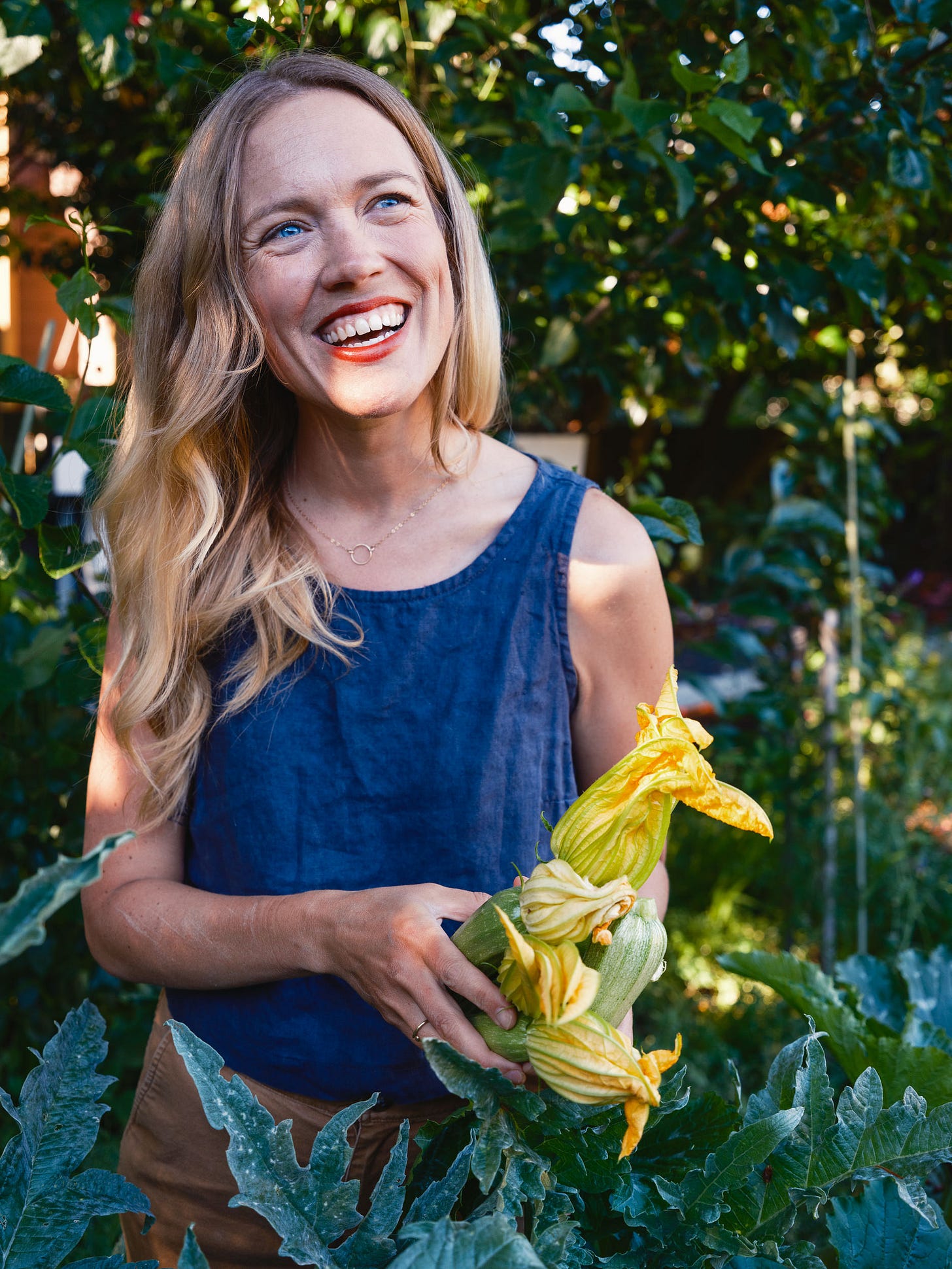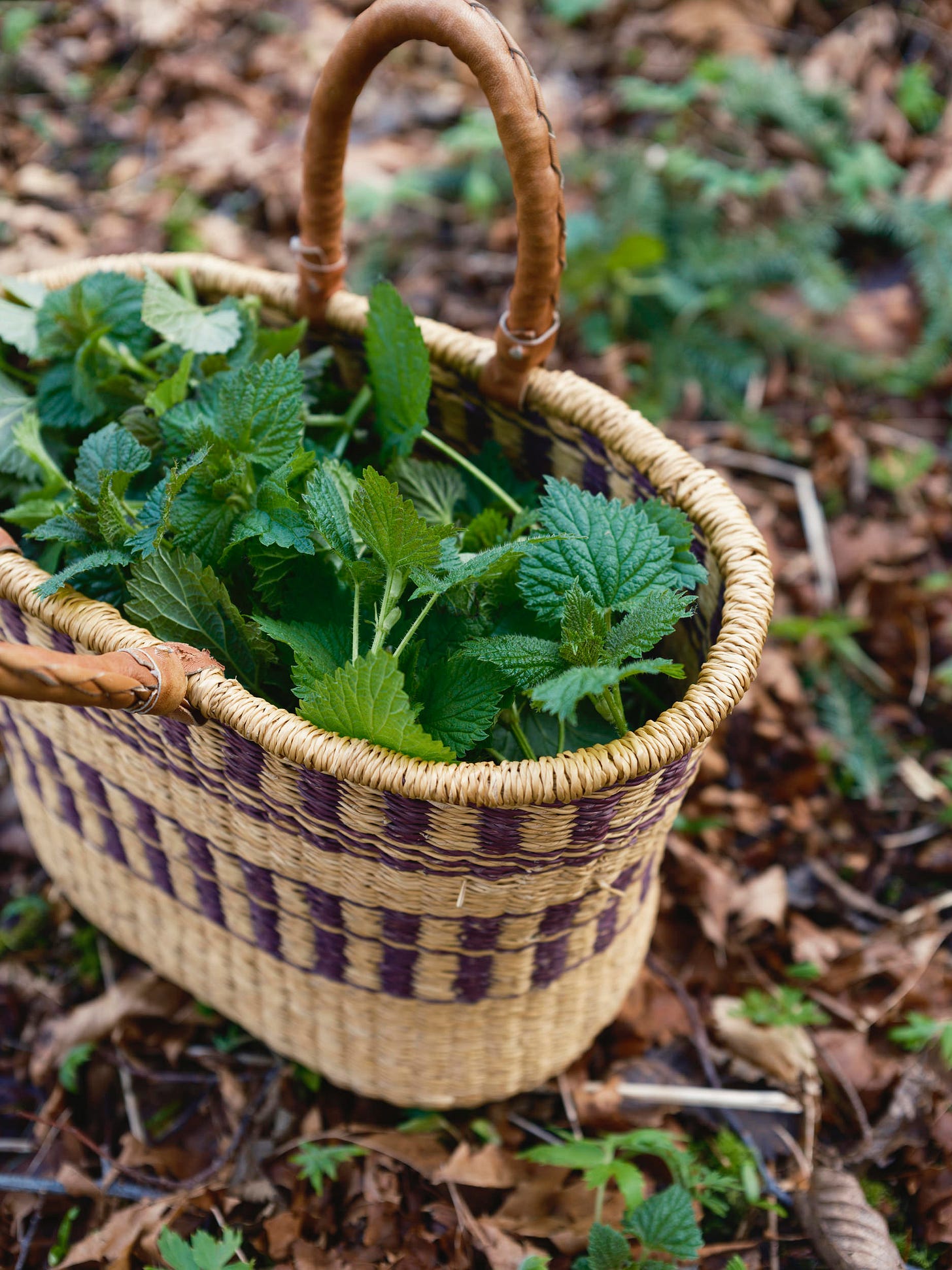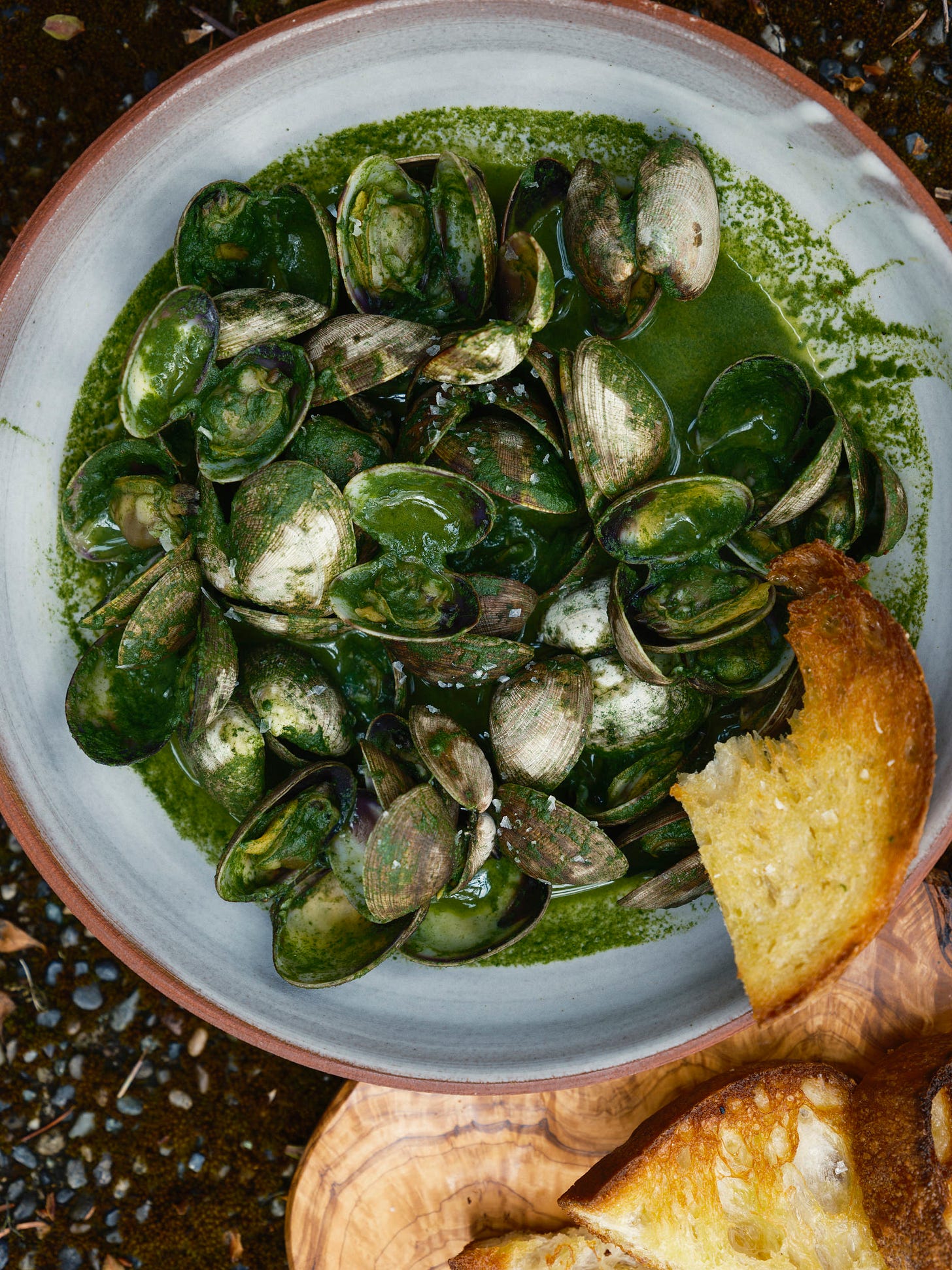# 222: Spring Nettles
A guest post from food writer Ashley Rodriguez about nettles and recipe for Clams in Nettle Cream Sauce that uses them.
Today is the first day of Spring and I’m delighted to share with you a special guest post from Ashley Rodriguez. I’ve known Ashley for many years, was with her when she found her first mushroom, and remember the day she and a video crew flew out on a chartered flight to Pie Cottage to film for a project she was working on. We made pie, we ate, we smiled and laughed a lot. What could be better than that!
Ashley’s newest book, Rooted Kitchen: Seasonal Recipes, Stories, and Ways to Connect with the Natural World was released earlier this month and I asked her if she might share some words and a recipe from it with us. Spring nettles are nigh upon us here in the PNW and in her words below, Ashley shares a few nettle memories from her younger years, information about what they are, and how to carefully harvest and use them, plus a delicious recipe for Clams in Nettle Cream Sauce. Enjoy!
And thanks, Ash, for being here with us today!
Words from Ashley
The following is from my new book, Rooted Kitchen. It is a guided seasonal meditation on the earth's movement as we pay close attention to, and honor the ingredients, that become our dear friends who visit us annually. We relish their presence when they arrive, and bid them adieu when their time has come. For when one is about to make an exit, another is waiting to be warmly welcomed. It’s about celebrating each season for the unique bounty it brings and in doing this we create a reciprocal relationship with the earth that not only has the power to change us but also, the earth herself.
“Sustain the ones who sustain you and the earth will last forever.”
—Robin Wall Kimmerer
Stinging Nettles
My first memory of nettles is not a pleasant one. As a kid I remember piling up the fall leaves to create an abundant cushion for me to land as I jumped off the tree swing. Propelling my legs up into the sky, I swing higher and higher, jumping off the wooden seat of the swing just as I hit the peak. Unfortunately, it wasn’t only the jewel toned leaves that broke my fall. Tucked under the leaves was a patch of stinging nettles. The tears and sobs were instant as I felt the pain from the sting of the tiny hairs on the stems and surface of the nettle leaves. These hairs inject a mix of acetylcholine, formic acid, histamine, and serotonin, causing an itchy, burning rash in many people and animals that may last up to 12 hours, although I have been known to be itchy up to 24 hours after being stung.
On hikes growing up and playing in our backyard I avoided any and all nettles, not wanting to relive that childhood misadventure. But my relationship to nettles changed as I got to know them more and learned they aren’t just a source of pain, but a nutritious and delicious gift from the earth. Now, nettles have become a beacon of spring to me. When winter’s cold dark months feel as if they will never relent, out pop the verdant green leaves of the stinging nettle. In the quiet late winter or early spring months they are often the first wild food to herald in the chorus of spring wild foods.
The stinging nettle is a tall, lanky perennial herb that grows in dense colonies often near roads, paths, trails, and walkways. Preferring a bit of disturbance, the nettle grows abundantly in rural and urban areas, making it an ideal and dependable wild edible.
The slender stalks are around 1 centimeter in diameter and are hollow with deep grooves running their length. At the height of summer the stalks can reach about 5 to 8 feet in height. The stem is made up of strong fibers that have long been used in basket weaving and making fabrics.
The leaves grow in opposite pairs along the stem. They are usually around 2 to 3 inches long and have saw-like teeth along the edges. The leaves roughly form the shape of a heart with a pointed tip jetting out furthest from the stem.
The flowers of the stinging nettles appear in small, branching clusters, typically less than 3 inches long.
Because of how bountiful this wild “weed” is and how quickly they produce I feel free to harvest in generous quantities. I still practice the guidance of honorable foraging which asks that you never forage all you find so you can leave plenty for other foragers and for the other beings inhabiting that ecosystem. I have no problem filling my baskets from a small patch I’ve found in my moi neighborhood with plenty left for others. Pick the plant with long sleeves over your arms, heavy gloves on your hands, and use scissors to protect against the sting. The stinging chemicals are tamed once the nettles have steeped in hot water. If you plan to use the greens for cooking you’ll need to blanch the leaves and tender young stems in boiling water for 30 to 60 seconds, then immediately submerge them in ice cold water.
Stinging nettles contain many nutrients such as Vitamins A, C, K, and several B vitamins including B9 (folic acid). All of the essential amino acids are present in nettles as well as the minerals, calcium, iron, magnesium, phosphorus, potassium, and sodium. These nutrients act as antioxidants that defend your cells against damage.
I’ve also found that since eating plenty of nettles in early spring my late spring allergies are far less miserable than what they once were. While it’s not definitive, there are studies that are showing this to be true. Research shows that stinging nettle extracts can inhibit inflammation that can trigger seasonal allergies. Although some say that the effects aren’t much better than a placebo, I know from my own experience that it has worked for me.
Traditionally, stinging nettle has been used to treat high blood pressure. The research is still unclear of this particular efficacy on humans but tests done on animals prove this to be true.
Note: If pregnant, consult your care provider before consuming.
Clams in Nettle Cream Sauce
Serves 4
Growing up in the Pacific Northwest I feel it’s almost my duty to love seafood but I have to admit it’s taken me well into adulthood to appreciate how good we have it here. In fact, I’ll be honest and say this dish is the first that I’ve had that has truly made me appreciate and enjoy clams.
It helps that the clams are bathed in the perfect hue of this season with this verdant sauce. It also helps that this sauce is filled with cream.
INGREDIENTS
1 cup nettle purée*
2 garlic cloves
1 1/2 teaspoons kosher salt
1 cup heavy cream (or coconut milk)
1/4 teaspoon chili flakes
1/4 teaspoon freshly ground nutmeg
1/2 cup water
4 pounds clams
Good sourdough for serving
In the bowl of a blender add the nettle purée, garlic, salt, cream, chili flakes, nutmeg and water. Blend until completely smooth. Scrape down the sides of the bowl and blend again.
Add this to a large pot with a lid and bring to a simmer. Pour in the clams, give it all a good stir to coat the clams in the sauce then cover the pot with the lid.
Cook just until the clams pop open, about 5 to 7 minutes.
Serve with plenty of bread for soaking up all of that sauce.
Nettle Purée
MAKES 1 CUP
This nettle purée lends itself beautifully to the homemade orecchiette, turning the pasta a beautiful shade of green and infusing it with vitamins and nutrients.
Nettles are best picked when they are young and tender, most commonly found in early spring. Snip the top couple of sets of small leaves off the plants while they are still just 6 to 8 inches off the ground. If picked young like this, the stems are still tender enough to use in the purée. If picking later in the season, just use the leaves.
Be sure to wear gloves and long sleeves when harvesting and handling fresh nettles, since the sting can be quite painful.
6 cups fresh nettles, packed
Kitchen Note
I leave salt out of the boiling water because I like to drink the water the nettles have boiled in as a tea.
Set up a large bowl of ice and water. Bring a large pot of water (see Note) to a boil.
Blanch the nettles for 1 minute, then scoop them out of the water using a sieve or tongs and immediately shock them in the ice water.
Squeeze out most of the water and transfer to a food processor or blender. Process until minced. You’ll need to stop the machine and scrape down the sides of the bowl with a rubber spatula a few times to get an even consistency in the purée.
Store in an airtight container for up to 1 week or freeze for at least 6 months.
Ashley Rodriguez is a Seattle-based award winning food writer and photographer. She is the author of three cookbooks; Date Night In, Let’s Stay In, and Rooted Kitchen. She is the host and co-creator of the James Beard nominated series, Kitchen Unnecessary. Ashley is a graduate of Seminary of the Wild through the Center for Wild Spirituality and a certified Nature and Forest Therapy guide. When not eating, or talking and writing about food you can find her foraging, fly fishing, feeding her sourdough starter and spending as much time outside as possible. She believes the outdoors is a place to be fed both physically and spiritually.
Here’s a link to Ashley’s Substack newsletter.














Happy Spring, Kate, and congratulations on the book, Ashley!
Awww, this newsletter warms my nettle loving heart! I'm polishing up a nettle spanakopita recipe and SO dang excited to be out foraging again. Thanks for sharing Kate!